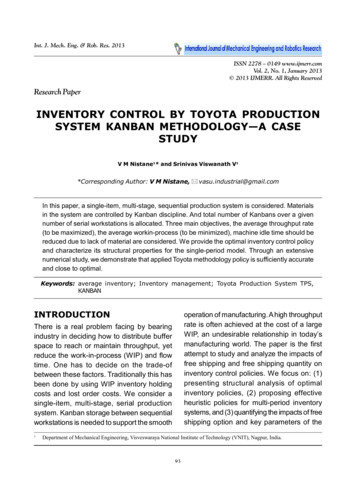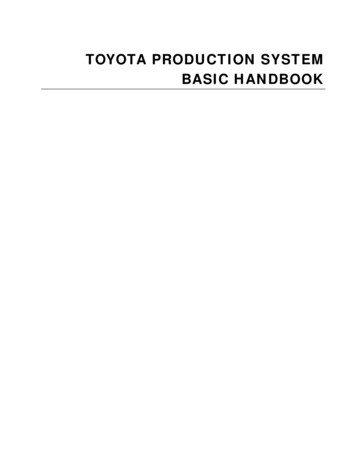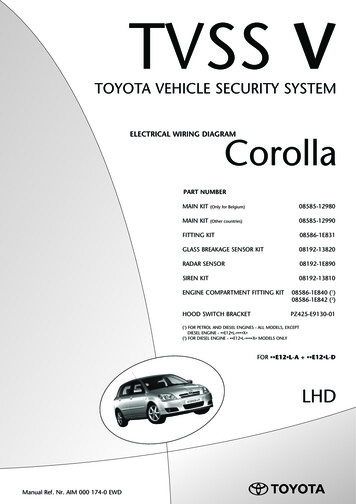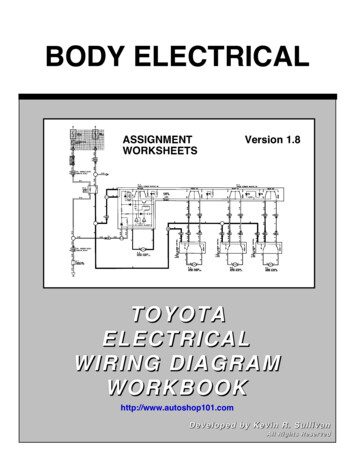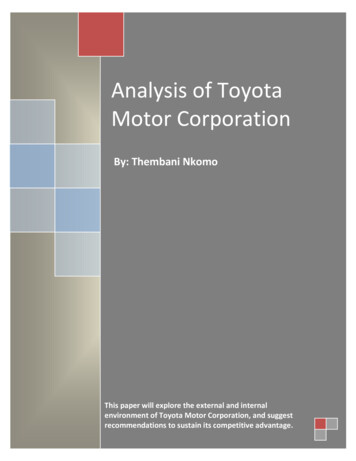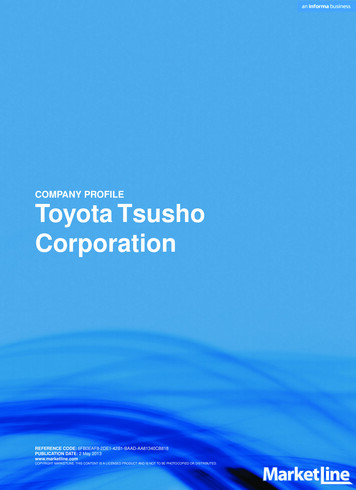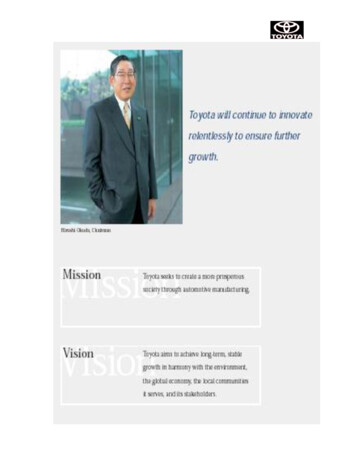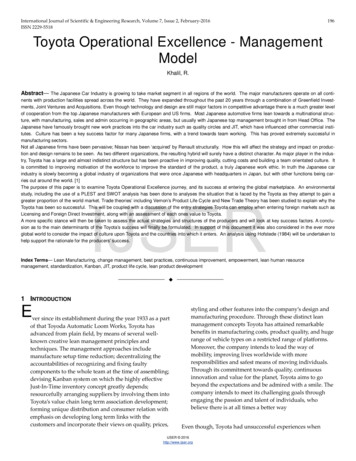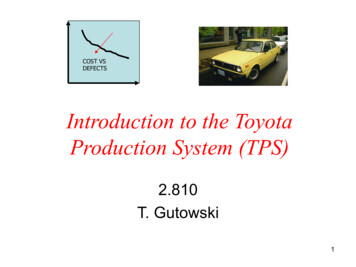
Transcription
COST VSDEFECTSIntroduction to the ToyotaProduction System (TPS)2.810T. Gutowski1
Three Major Mfg Systemsfrom 1800 to 2000Machine tools, specialized machine tools, Taylorism, SPC, CNC, CAD/CAM1800InterchangeableParts at U.S.Armories1900MassProductionat Ford2000ToyotaProductionSystem2
1980’s OPEC oilembargo drivesup fuel prices,Japanimports smallcars with increasedfuel mileage3
Consumer Reports4
How we learned about TPS Quality of cars - but not right awayPilgrimages - Hayes, Wheelwright, ClarkJoint ventures - Nummi-Geo Japanese NA operations-Georgetown, KYJapanese sages- Ohno, Shingo, MondenAmerican translation- “Lean”, J T. Black.Consulting firms- Shingjutsu, 5
Toyota Production System Development History - Taiichi Ohno30 years of development 1945 to 19756
Translation: there is no“Silver Bullet Technology”.This is more system &management thantechnology.7
REFERENCES ON THE TOYOTAPRODUCTION SYSTEM;Taiichi Ohno, “The Toyota ProductionSystem” Productivity Press 1988Shigeo Shingo, “A Study of the ToyotaProduction System” Productivity Press1989Yasuhiro Monden, “Toyota ProductionSystem”, 2nd Ed 1983Hayes, Wheelwright and Clark,“Dynamic Manufacturing” Free Press1988Womack and Jones, “Lean Thinking”Simon and Schuster, 19961990Spear & Bowen, “The DNA of the TPS’HBR 19998
Performance Observations Early observations of reliability, after someinitial start-up problems IMVP got actual factory level data 1980’s– defect counts– direct labor hours for assembly– level of automation9
Summary of Assembly Plant Characteristics, Volume Producers,1989(Average for Plants in Each Region)10
Cost Vs DefectsRef. “Machine that Changed the World” Womack, Jones and Roos11
Cost Vs AutomationRef. “Machine that Changed the World” Womack, Jones and Roos12
History of the Development of the ToyotaProduction Systemref; Taiichi Ohno19451975inventoryset-upcellsAndon13
14Ref Yasuhiro Monden
Basic Goal To reduce cost by Elimination of waste– Excessive production resources– Overproduction– Excessive inventory– Unnecessary capital investment Respect for peopleSee Toyota Production System, Yasuhiro Monden15
Simulation of a 20 machine, 19 buffer (cap 10 parts)Transfer line. Each machine with one minute cycle timecould produce 4800 parts per week. MTTF 3880 minutes,MTTR 120 minutes. See Gershwin p63-64Perfect machines, buffer bufferAve (3249 sim, 3247 analy)Zero bufferN* 240 parts16
Buffer capacity Vs MTTR MTTR 120 minutes N* 2 x 120 x 1 part/minute 240 240 x 19 buffers 4560 ( one week) There must be a better way!CHANGE THINKING, REDUCE VARIATION17
What causes variation? Quality issues Delivery time issues Unavailable resources issues18
What causes variation? Quality issues– Check quality, prevent propagation Delivery time issues– Just in Time, smooth flow, mix models,standard work Unavailable resources issues– Flexible machines and cross trained workers19
Quality Issues Make quality problems obvious– Error checking (Pokeyoke), Pull system Reduce WIP, which hides problemsStop the lineFix it nowCooperative problem solving20
Delivery Time Issues Kanban card: type & quantity needed– Smooth production– “Takt” time available time/demand– Standardize work– Reduce set-up– Design machine layout - TPS cells– Autonomation - autonomous defect controlMonden21
Unavailable Resource Issues Fast set up– Single Minute Exchange of Dies (SMED) Flexible (general purpose) machines– Toyota Cells Cross-trained work force22
Autonomation Monden claims that the word “autonomation” comes from the Japanese word Jidoka. whichhas two meanings, the first is automation in the usual sense, to change from a manual processto a machine process. The second meaning is “automatic control of defects”. He says this isthe meaning coined by Toyota. This second meaning is sometimes referred to as NinbennoaruJidoka, which literally translates into automation with a human mind. Monden goes on to saythat “although autonomation often involves some kind of automation, it is not limited tomachine processes but can be used in conjunction with manual operations as well. In eithercase, it is predominantly a technique for detecting and correcting production defects andalways incorporates the following devices; in mechanism to detect abnormalities or defects; amechanism to stop the line or machine when abnormalities or defects occur. When a defectoccurs, the line stops, forcing immediate attention to the problem, an investigation into itscauses, and initiation of corrective action to prevent similar defects from occurring again ” Reference; Yasuhiro Monden, Toyota Production System,23
J T. Black’s 10 StepsRef; JT. Black “Factory with a Future” 19911. Form cells2. Reduce setup3. Integrate quality control4. Integrate preventive maintenance5. Level and balance6. Link cells – KANBAN7. Reduce WIP8. Build vendor programs9. Automate10. Computerize24
J T. Black –1, 21. Form Cells2. Reduce SetupSequentialExternalize setup tooperations, decouplereduce down-timeoperator fromduring changeover,machine, parts instandardize set-upfamilies, single pieceflow within cell25
Toyota Cell, one part is producedfor every trip around the cellTPS CellJ T. Black26
J T. Black – 3, 43. Integrate qualitycontrolCheck part quality atcell, poke-yoke, stopproduction whenparts are bad, makeproblems visible,Andon - info aboutwork being done 4. Integrate preventivemaintenanceworker maintainsmachine , runsslower, operator ownsproduction of part27
J T. Black – 5, 65. Level and balanceProduce to Takttime, reduce batchsizes, smoothproduction flow,produce in mix tomatch demand6. Link cells- KanbanCreate “pull” system– “Supermarket”System thatindicates the statusof the system28
Balancing and Leveling Balanced line: adjust process time forsmooth flow “Takt time” Leveled Line: each product is produced inthe needed distribution.AABCA29
Pull System at the Supermarket30
Pull SystemsThe orders arrives at the end of the line and are “pulled” out of thesystem. WIP between the machines allows quick completion. System stops when there are noorders Disruptions are obvious Product differentiation at the end31
Push Systems –Order (from centralized decision process) arrives at the front of thesystem and is produced in batches of size “B”.Process time at each step may not be balanced.123 .NTime 0Time T1Time T2Time T3Time 32TN
J T. Black – 7, 87. Reduce WIPMake system reliable,build in mechanismsto self correct,reduceinventory8. Build Vendor programPropagate low WIPpolicy to yourvendors, reduce # ofvendors, make ontime performance partof expectation33
TPS Cell: Example1. Work flow (part separate from worker)2. Standard work (highly specified)3. Production rate flexibilityRef: J T. Black Ch 434
Machining CellOperator moves partfrom machine to machine(including “decouplers”)by making traversearound the cell.35
Cell Features “Synchronized”, sequential production Operator decoupled from individualmachines Operator integrated into all tasks Goal: single piece Flow Best with single cycle automatics, but canbe done manually tooSee Brigg & Stratton Video36
Walking segments - 10Machining CellsegmentManual(Sec)Walk rtTotals3567489321013M W 15349037
Parts in the cell 14Machining CellManual(Sec)RawWalk 120VM120370VM220360G15360F.I.193 3TotalsM W 153489143101112132113 parts49038
Standard Work for CellCell produces one part every 153 secNote: machine time Max (MTj) cycle time CTi.e. 120 12 15339
TPS Cell1. Production rate l2. WIP L?3. Time in the system W?40
Number of round trips; 13Machining Cell76Saw3 15 153#1decoupler1.5 153L11.5 10 153 . .Grind1.5 15 153Manualand walk19 3out150153X13 19898951011412313211989 150 213941
By Little’s LawL (13 1) X (150/153) 13 X (3/153) 13.98 partsrate, l 1/153 parts/secondW 153 X 13.98 2139 sec42
TPS CellIncrease production rate:a) add additional worker to cellb) modify machine bottlenecks43
Manual(Sec)RawWalk to(Sec)Machine(Sec)To increase production rate add 2nd worker3Saw15360L1103 370L212350HM123120VM120370VM2203 360G15360F.I.193 3TotalsM W 159Work 180Work 279WORKER 2WORKER 149044
What is the production rate forthis new arrangement?Check max(MTj) CTWorker 1;80 80Worker 2;12 120 79One part every 132 secondsWe are limited by the HM (horizontal mill)Can we shift work off of the HM to reduce the cycle time?45
Manual(Sec)RawWalk to(Sec)Machine(Sec)3Saw15360L1103 370L212350HM123120WORKER 280VM12037080VM2203 3WORKER 16090G153F.I.193 3TotalsM W 159Work 180Work 2796049046
Standard Work for Worker #2Cycle # 1Cycle # 2 3Operator waitingOn machine47
What is the new productionRate?Check max(MTj) CTWorker 1;80 80Worker 2;110 79Hence Worker #2 will be waiting onVertical Mill #248
What is the new productionRate? The new production rate is;one part every 110 sec Pro and Cons; Worker “idle”, can’t speedup by adding additional worker Design for flexibility make;Max(MTj) CT/249
Manual(Sec)RawWalk to(Sec)Machine(Sec)3Saw15360L1103 370L212350HM123120VM120370VM2203 360G15360F.I.193 3TotalsM W 159Work 180Work 279Alternative solution add 2 HM’sABWORKER 2WORKER 1490Almost double!50
TPS cell summary1.2.3.4.Original cell Additional worker Shift work add additional VM23.5 parts/hr27.3 parts/hr32.7 parts/hr40 parts/hr51
TPS Implementation Physical part (machine placement,standard work etc) Work practices and people issues Supply-chain part Corporate Strategy (trust, job security)52
Is there a best way to build a car? Maccoby HBR 1997Other Ref: “Just Another Car Factory” Rinehart, Huxley and Robertson,“Farewell to the Factory”, Milkman53
Work practices and peopleissues “Failed” TPS attempts; GM Linden NJ,CAMI, GM-Suzuki, Ontario Canada. Successes GM NUMMI, Saturn. ToyotaGeorgetown, KY Maccoby HBR 1997 Other Ref: “Just Another Car Factory” Rinehart, Huxley andRobertson, “Farewell to the Factory”, Milkman54
According to Maccoby’s Review Failure Examples:– failures at middle management– pressure from above to meet targets, lack oftrust from below, but – both plants adopted some aspects of lean,and– both plants improved55
NUMMI and Georgetown workers have different attitude do not fear elimination play important role .go to Georgetown and find out56
NUMMI plant today - Tesla57
TPS Summary High quality and low cost paradigm shift Many elements to the system– Make system observable– Produce to demand– Study defects and eliminate– Institutionalize change– Trust Many companies have imitated TPS58
Key Elements for New Mfg SystemsElement/SystemNeed erInterchange- Militaryable Parts“YankeeIngenuity”MachineTools,Division ofLaborRoswell U.S.Lee/GovtJohnHallMassProductionTransportation ngsToyotaProductionSystemPost War ksResources59
ReadingsJames Womack, Daniel T. Jones and Daniel Roos,The Machine that Changed the World, 1990, Ch 3 and 4J T. Black “The Factory with a Future” Ch 2 & 4Yasuhiro Moden Ch 1Michael Maccoby, “Is There a Best Way to Build a Car?”HBR Nov-Dec 199760
“The DNA of the TPS” Spear and Bowen 4 years 40 plants HBR Sept-Oct 1999 Four Rules:61
Four Rules Rule 1: All work shall be highly specified as to content, sequence, timingand outcome. Rule 2: Every customer-supplier connection must be direct, and there mustbe an unambiguous yes-or-no way to send requests and receive responses. Rule 3: The pathway for every product and service must be simple anddirect. Rule 4: Any improvement must be made in accordance with the scientificmethod, under the guidance of a teacher, at the lowest possible level in theorganization.Spear and Bowen62
management than technology. 8 REFERENCES ON THE TOYOTA PRODUCTION SYSTEM; Taiichi Ohno, “The Toyota Production System” Productivity Press 1988 Shigeo Shingo, “A Study of
